As an Amazon Associate, I earn from qualifying purchases.

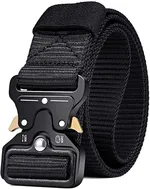
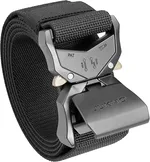
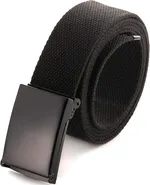
If your back aches after a long shift, your belt setup could be the cause. A poor fit can slow you down and cause pain fast. The best police duty belt setup helps you move with ease and keeps your gear close when seconds count.
Over the years, I’ve tested all kinds—Velcro double-belt systems, leather rigs, and padded nylon belts. Some slipped. Some pinched. The right one made all the difference.
Contents
- 1 Best 10 police duty belt setup comparion table
- 2 10 Best police duty belt setup
- 2.1 JUKMO Tactical Belt, Military Hiking Rigger 1.5″
- 2.2 MOZETO Tactical Belts for Men Military Style Work
- 2.3 DOOPAI Tactical Belt for Men
- 2.4 JUKMO Stretch Tactical Belt for Men
- 2.5 Groove Life Groove Belt Men’s Stretch Nylon Belt
- 2.6 Mile High Life Cut To Fit Canvas Web Belt
- 2.7 FAIRWIN Men’s Tactical Belt
- 2.8 CHAOREN Mens Belt Leather Ratchet Belt
- 2.9 BULLIANT Tactical Belt for Men
- 2.10 JUKMO Men’s 1.5″ Nylon Ratchet Belt
- 3 Holster Positioning and Pouch Placement Tips of best police duty belt setup
- 4 What to Carry: Police Uniform Essentials and Tactical Belt Accessories
- 5 Step-by-Step Guide to Configuring a Law Enforcement Duty Belt
- 5.1 1. Start with the Belt Base: Leather or Nylon?
- 5.2 2. Velcro Double-Belt Systems vs. Belt Keepers
- 5.3 3. Holster Positioning: Strong Side or Cross-Draw?
- 5.4 4. Gear Placement: Where Does Everything Go?
- 5.5 5. Adding Tactical Accessories: What to Include?
- 5.6 6. Testing the Setup: Comfortable and Accessible
- 6 FAQ of Best police duty belt setup
- 6.1 What is the best police duty belt setup for comfort?
- 6.2 How do I properly configure my duty belt?
- 6.3 Velcro double-belt system vs. belt keepers—what’s better?
- 6.4 What are must-have accessories on a tactical duty belt?
- 6.5 Should I choose a leather or nylon duty belt?
- 6.6 Which belt is so helpful for military aggression?
- 7 Conclusion
Best 10 police duty belt setup comparion table
Image | Brand | Key Feature | Price |
JUKMO | Military-grade webbing construction. Adjustable length to fit various waist sizes. Price range: $25 – $35. | ||
MOZETO | Durable nylon material. Adjustable buckle for a secure fit. Price range: $20 – $30. | ||
DOOPAI | Quick-release buckle. Adjustable fit for comfort. Price range: $25 – $35. | ||
JUKMO | Stretchable material for added comfort. Durable build for tough conditions. Price range: $20 – $30. | ||
Groove Life | Stretch nylon material for comfort. Durable construction for everyday wear. Price range: $30 – $40. | ||
Mile High Life | Customizable length for a perfect fit. Durable canvas construction. Price range: $15 – $25. | ||
FAIRWIN | High-quality nylon material for durability. Secure and sturdy buckle. Price range: $20 – $30. | ||
CHAOREN | Leather material for a stylish look. Ratchet mechanism for easy adjustments. Price range: $30 – $40. | ||
BULLIANT | Military-grade webbing construction. Secure and comfortable fit. Price range: $20 – $30. | ||
JUKMO | Ratchet system for easy adjustments. Durable nylon material. Price range: $25 – $35. |
10 Best police duty belt setup
JUKMO Tactical Belt, Military Hiking Rigger 1.5″

Pros
-
Adjustable size for a personalized fit.
-
Ideal for tactical and outdoor activities.
Cons
-
Can be a bit stiff initially and takes time to break in.
The JUKMO Tactical Belt is a durable and reliable choice for any rugged outdoor activity. It’s designed with military-grade materials to handle tough conditions. This belt is ideal for hiking, tactical operations, and everyday use. It offers adjustable sizing, ensuring a snug and comfortable fit. Whether you’re carrying heavy gear or looking for support, this belt can meet your needs.
MOZETO Tactical Belts for Men Military Style Work

Pros
-
Strong nylon construction for long-lasting wear.
-
Ideal for a variety of tactical and outdoor activities.
Cons
-
Buckle may be too bulky for some users.
The MOZETO Tactical Belt is a heavy-duty option designed for daily wear and tactical use. It features a sturdy, military-style design that’s perfect for work, outdoor adventures, or police duty. The belt is made from high-quality nylon for strength and durability. With its adjustable buckle, you get a customizable fit that stays in place all day.
DOOPAI Tactical Belt for Men
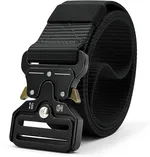
Pros
-
Quick-release buckle for easy access.
-
Flexible and strong, suitable for a variety of uses.
Cons
-
The belt is a bit wider than typical options, which may not fit some pants.
The DOOPAI Tactical Belt offers great strength and durability for tactical use. It’s designed for those who need a secure and reliable belt for various activities. The belt features a quick-release buckle and a flexible fit, making it perfect for law enforcement, military, or outdoor tasks.
JUKMO Stretch Tactical Belt for Men
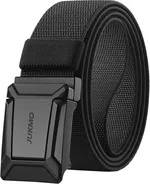
Pros
-
Strong and durable, made for tough tasks.
-
Ideal for a variety of outdoor and tactical activities.
Cons
-
Stretching might wear out with extensive use.
The JUKMO Stretch Tactical Belt combines comfort with strength for tactical and everyday wear. Its stretchable design provides a flexible fit, adapting to your movements. This belt is perfect for anyone needing a versatile option for outdoor adventures or duty use.
Groove Life Groove Belt Men’s Stretch Nylon Belt

Pros
-
Sleek, stylish design suitable for various uses.
-
Durable and long-lasting construction.
Cons
-
The stretch nylon can lose its elasticity over time.
The Groove Life Groove Belt is an innovative tactical belt made from high-quality stretch nylon. It’s designed for both comfort and durability, offering a unique look with a flexible fit. This belt works well for tactical purposes or as an everyday accessory.
Mile High Life Cut To Fit Canvas Web Belt

Pros
-
Customizable length to fit any waist size.
-
Strong canvas material for durability.
-
Great for tactical and casual wear.
Cons
-
Canvas material may fray over time with heavy use.
The Mile High Life Cut To Fit Canvas Web Belt offers a customizable fit for those who want a versatile and durable tactical belt. This belt is made from sturdy canvas material, ensuring it can handle tough situations. Its adjustable design makes it easy to get the perfect fit.
FAIRWIN Men’s Tactical Belt
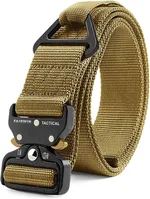
Pros
-
Durable nylon material.
-
Reliable buckle design for a secure fit.
-
Versatile for tactical or casual wear.
Cons
-
Buckle may be bulky for some users.
The FAIRWIN Men’s Tactical Belt is a strong, reliable option designed for everyday wear or tactical use. It’s made from high-quality nylon and features a durable buckle that ensures a secure fit. Whether you’re using it for work or outdoor adventures, this belt holds up under pressure.
CHAOREN Mens Belt Leather Ratchet Belt
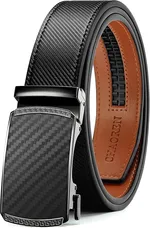
Pros
-
Elegant leather design for a polished look.
-
Ratchet mechanism allows for precise adjustments.
-
Comfortable fit for all-day wear.
Cons
-
Leather may require more maintenance than synthetic materials.
The CHAOREN Men’s Leather Ratchet Belt provides a sleek and stylish design that combines elegance with function. It features a unique ratchet mechanism, allowing for precise adjustments. Ideal for both casual and professional wear, this belt is perfect for those seeking style and comfort.
BULLIANT Tactical Belt for Men
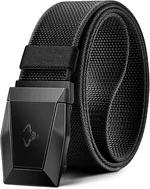
Pros
-
Military-grade durability.
-
Comfortable and secure fit.
-
Ideal for both tactical and casual use.
Cons
-
May be too rigid for some users.
The BULLIANT Tactical Belt offers a sturdy, military-grade design made for durability and versatility. Perfect for tactical use, this belt provides a secure fit while offering comfort for all-day wear. It’s great for law enforcement or outdoor activities that require tough, reliable gear.
JUKMO Men’s 1.5″ Nylon Ratchet Belt
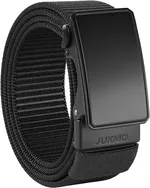
Pros
-
Ratchet system allows for easy and precise adjustments.
-
Durable nylon construction for toughness.
-
Comfortable fit for all-day wear.
Cons
-
The buckle can be a bit heavy for some users.
The JUKMO Men’s 1.5″ Nylon Ratchet Belt is a versatile and sturdy belt, designed for optimal comfort and support. Featuring a ratchet system for easy adjustments, this belt is ideal for everyday use or tactical activities. Its durable design ensures it lasts under tough conditions.
Holster Positioning and Pouch Placement Tips of best police duty belt setup
Setting up your holster right on your duty belt is key. It helps you move fast and grab your gear quickly. I’ve tried different setups over the years. Some worked well, and others didn’t. Here’s what I found that works best.
I always keep my holster on my strong side, around 3 or 4 o’clock. This makes it easy to reach with my right hand. It’s quick and natural. If you’re left-handed, you can set it up the same way on the opposite side.
I’ve also tried a cross-draw setup. It can be good, especially when sitting down. But for me, it felt a bit awkward in most situations. I stick to the strong-side draw now.
What to Carry: Police Uniform Essentials and Tactical Belt Accessories
When setting up your police duty belt, it’s important to have the right gear. You need to carry items that keep you safe and ready. Here’s what most officers carry—and why it matters.
Radio: This is a must-have. Your radio helps you stay in touch with your team. I keep mine on the left side, so I can grab it quickly when needed.
Handcuffs: These go on the opposite side of your holster, around 8 to 10 o’clock. This way, you can reach them fast if you need them.
Flashlight: A good flashlight is key at night. I keep mine on the left, behind the handcuffs. That way, I can grab it easily when it’s dark.
Pepper Spray: This is for non-lethal force. I carry it just below my holster, on the dominant side. It’s easy to grab if I need it in a hurry.
Gloves: Gloves are small but important. I keep mine in a pouch near my med kit. That way, I can grab them fast if I need to handle something dangerous.Med Pouch: The med pouch is for emergency help. I always keep it within reach, but not too close to the front. It’s vital for quick medical assistance.
Step-by-Step Guide to Configuring a Law Enforcement Duty Belt
Setting up a duty belt can make or break your shift. The right setup helps you stay fast, efficient, and comfortable. Here’s how I’ve configured mine over the years. I’ll share what works best based on my own experience and offer tips to help you get the most out of your gear.
1. Start with the Belt Base: Leather or Nylon?
When it comes to choosing between leather or nylon, I always recommend nylon for its flexibility. Nylon duty belts hold up well to wear and tear. They also have some stretch, which makes them more comfortable during long shifts. Leather is classic, but it can be stiff and heavy after a while.
Nylon is also lighter, which is great if you’re carrying a lot of gear. Plus, it’s easier to clean. If you’re working in harsh environments, I recommend a heavy-duty nylon belt.
2. Velcro Double-Belt Systems vs. Belt Keepers
Now, let’s talk about securing your belt. I’ve tried both Velcro double-belt systems and belt keepers. The Velcro system is quick to put on and adjust. It feels snug and stays in place without slipping. But belt keepers give a more secure fit. They prevent the belt from shifting, especially if you’re carrying heavier gear.
For me, Velcro double-belt systems work best for quick adjustments, but belt keepers are a solid choice for a tight fit. The choice comes down to personal comfort and preference.
3. Holster Positioning: Strong Side or Cross-Draw?
The placement of your holster is key. I’ve always kept my holster on my strong side, at about 3 o’clock. This gives me easy access with my dominant hand, making it quick to draw. It’s natural and fast.
If you’re left-handed, simply place the holster on your opposite side. I’ve experimented with cross-draw setups, but for me, strong-side holsters just work better. They’re faster when I’m standing or moving.
4. Gear Placement: Where Does Everything Go?
The next step is deciding where to put your gear. Here’s how I set mine up:
- Radio: I keep mine on the left side, so I can grab it quickly without fumbling.
- Handcuffs: I place them opposite my holster, around 8-10 o’clock. That way, I can grab them fast when needed.
- Flashlight: For night shifts, I keep my flashlight right behind my handcuffs. It’s crucial for visibility in dark situations.
- Pepper Spray: I prefer it below my holster, on my dominant side. Quick access is essential, especially for non-lethal situations.
These are just a few essential items, but the key is making sure your gear is within reach and organized.
5. Adding Tactical Accessories: What to Include?
The accessories you add to your duty belt depend on your needs. I always carry a small med kit, gloves, and a multitool. The med kit should be within easy reach but not in the way. I store mine toward the back of my belt.
A multitool is essential for a variety of situations, and I keep mine tucked to the side. It’s out of the way but easy to grab when I need it.
6. Testing the Setup: Comfortable and Accessible
Once you’ve got everything placed, try wearing your duty belt around. Walk, squat, bend, and reach. Make sure you can access everything without straining. Your belt should feel comfortable but secure. If you feel like something is off, adjust the position of your gear until it feels right.
FAQ of Best police duty belt setup
What is the best police duty belt setup for comfort?
A: The best setup balances weight across your hips, uses padded belts or suspenders, and avoids overloading one side. Comfort starts with good gear placement and ends with a supportive inner belt system.
How do I properly configure my duty belt?
A: Start with your dominant hand side for your firearm and place other tools in the order of frequency and urgency—radio, cuffs, OC spray, etc. Think: muscle memory and accessibility.
Velcro double-belt system vs. belt keepers—what’s better?
A: Velcro systems offer more stability and faster removal, while belt keepers are budget-friendly and widely used. It really depends on your comfort and department policies.
What are must-have accessories on a tactical duty belt?
A: Holster, magazine pouch, flashlight, handcuff case, radio pouch, gloves, and first-aid kit are essentials. Optional: multitool, tourniquet, baton holder.
Should I choose a leather or nylon duty belt?
A: Nylon is lightweight, water-resistant, and flexible. Leather is more traditional and durable but can feel stiff. Go with what feels better during long shifts.
Which belt is so helpful for military aggression?
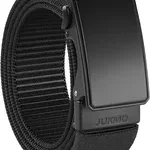
The JUKMO Men’s 1.5″ Nylon Ratchet Belt is a versatile and sturdy belt, designed for optimal comfort and support. Featuring a ratchet system for easy adjustments, this belt is ideal for everyday use or tactical activities. Its durable design ensures it lasts under tough conditions.
Conclusion
If your back aches after a long shift, your duty belt might be the reason. A bad setup can slow you down and cause pain fast. But the best police duty belt setup helps you move with ease and reach your gear fast—because in this job, every second counts.
I’ve tested them all over the years—Velcro double-belt systems, stiff leather rigs, padded nylon belts. Some slipped. Some pinched. But the right one? It made all the difference.
As an Amazon Associate, I earn from qualifying purchases.
